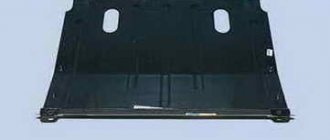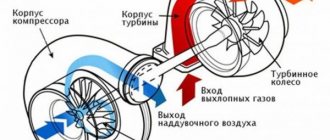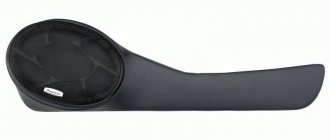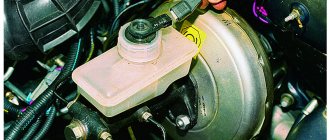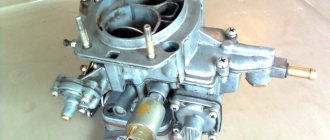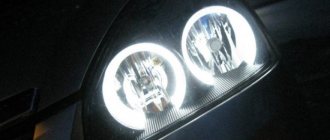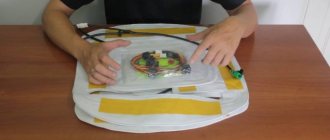Almost all car enthusiasts today are trying to somehow make their car stand out from the crowd, to make the car special. Driving performance is improved almost immediately after purchase. You can often find a turbo VAZ on the roads. By installing turbocharging on AvtoVAZ engines, you can significantly increase engine power. But without a turbine, but with the installation of tuned components, it will not be possible to obtain a significant increase in power. Let's see how to assemble a turbocharged engine for a VAZ.
What you need to know about supercharging
Turbocharging is the forced injection of air into the combustion chambers by creating a high-pressure zone at the inlet of the intake tract. When the driver of the car presses the pedal and the throttle valve opens, significantly more air will enter the intake manifold than if it were supplied at atmospheric pressure. As the amount of oxygen increases, the carburetor or injector also increases the amount of fuel. Due to this, the engine power increases.
The combustion chamber has a fixed size, and its volume is a constant value. On a standard engine, only a limited amount of the fuel mixture fits into it. To increase power, it is necessary to place a larger volume of fuel in the cylinder. This is achieved by creating high pressure, which will compress the mixture. Then it will take up less space. This is why turbocharging is needed.
How to install a turbine on a VAZ 2114
Installing a turbine on a VAZ 2114 requires preliminary preparation.
You need to purchase spare parts for VAZ in the store:
- new pistons and rings (possibly from Niva);
- cylinder head gasket;
- fuel pressure control;
- throttle valve;
- vacuum tube system.
If the turbo system is not supplied as a kit, but only a turbocharger is available, you need to buy:
- intake receiver and exhaust manifold;
- fuel pump - preferably with a capacity of 130 liters per hour. Submersible gasoline pumps from various manufacturers are suitable for injection-type engines. When selecting, you need to focus on the desired engine power;
- fuel injectors with the ability to supply a larger volume of fuel - possible from Volga or Subaru;
- overpressure relief valve;
- boost controller – a controller for regulating turbocharger pressure. It can be mechanical or in the form of an electromagnetic valve;
- pipes, clamps, gaskets, etc.
Be sure to purchase new sensors - absolute pressure and pressure in the turbine, and air temperature in the intake manifold.
Next, it is necessary to inspect the engine - disassemble and fully inspect its key mechanisms (cylinders, valves, crankshaft, oil pump, etc.). If necessary, replace with new ones. Spark plugs and ignition system wires may also need to be replaced.
Sequentially install all components of the turbo system. To adjust the operation of the turbo engine, it is advisable to seek the services of a specialist.
Thus, installing a turbocharger on a VAZ 2114 can significantly increase engine power and improve vehicle performance. The main thing is to choose the right turbocharger and components, and take a responsible approach to installation and configuration issues.
Where to begin?
Not every car is suitable for tuning. It is important to pay attention to the condition of the car. It is better to disassemble the car to the ground. The main problem is corrosion. You need to understand that the metal on AvtoVAZ cars is quite thin, and high loads are contraindicated for it. If you apply a serious load, the rusty metal will literally tear.
You should start by replacing the metal in the engine compartment with a more powerful one. When all body faults have been repaired, you can continue tuning further. If the car was purchased specifically for tuning, then the first thing you need to do is get it moving in stock condition. Next, they change the electrical wiring, bring the engine into good condition, or change it to a sixteen-valve one. The brake system and transmission are also inspected.
This is the first point from which the instructions for turbocharging begin. When the iron has returned to an ideal, close to factory condition, you can continue further. Moreover, we already know enough about turbocharging equipment.
Suitable engines
The easiest way is to make a VAZ turbo based on a 16-valve unit. It has a fairly simple design and is therefore also easy to tune and maintain. And most importantly, it is ideal for motorsports, as it can produce sufficient power at minimal cost.
Old engines equipped with a carburetor power system are practically not amenable to such tuning. But some craftsmen still build a turbo VAZ-2106. 8-valve injection engines would be suitable for civilian use, but in motorsport every horsepower is needed and important. Auto tuning experts recommend using 16-valve VAZ engines.
Turbocharger
This supercharger is made as a separate unit, which is driven by a drive belt.
The latter will take torque from the crankshaft. The compressor is in no way connected to the lubrication or cooling system of the engine. To relieve excess pressure, which sometimes occurs in the intake tract in some operating modes, an additional valve is connected to the air valves. Often, two types of compressors are used for tuning cars - centrifugal and screw. The first is made in the shape of a snail, inside of which there is an impeller. In a screw compressor, pressure is obtained through the simultaneous rotation of two shafts equipped with blades.
Centrifugal compressors are used for self-tuning of cars. They are more affordable, have small overall dimensions, and are easy to install. Due to the fact that the performance characteristics are limited by the engine speed, it can produce no more than 0.7 Bar of pressure. The compressor can increase engine power from 15% to 30% at maximum speeds of up to 40 thousand per minute. This is a pretty serious indicator.
Among the advantages of compressors are high durability and reliability, low requirements for the condition of the motor, ease of installation, and accessibility. During operation of the turbocharger, pickup occurs at speeds of three or more. The engine immediately responds to pedal pressure - in this case there is no so-called “turbo lag”, which happens when installing other superchargers. However, at high engine speeds (more than five thousand), the increase in power is almost unnoticeable.
Turbocharging for a VAZ, who cares
Turbocharging on a VAZ is certainly exotic. But the power advantages of turbo engines over “aspirated” ones themselves encourage the emergence of more and more cars that received a turbine. And not all of these cars are foreign cars...
Theory
Let's start with the theory. There is simply supercharging (mechanical supercharging, charger) and there is turbocharging. In both cases, the boost is created by a turbine installed between the air filter and the intake manifold. The difference is what exactly drives it.
In the first case, the engine itself turns the turbine. One of the advantages is the direct dependence of the turbine speed (the pressure created by the turbine) on the speed, i.e. no delayed reaction (turbo lag). The downside is that the engine spends part of its power spinning up the turbine.
Turbocharging is more complicated because consists of 2 turbines. One pumps more air into the engine and is driven by another turbine, which is installed immediately behind the spider (exhaust manifold). Thus, the chain looks like this: exhaust gases rotate one turbine, which is connected to a second turbine that forces air into the engine. The advantage of turbocharging is that it has greater efficiency because does not require engine power to rotate it. Minus turbo in the presence of the “turbo lag” effect. What does it look like? You sharply press the gas to the floor and wait for an instant response from the engine. And in order for a turbo engine to produce maximum power, it is necessary to sufficiently spin up the turbine, which “comes to life” only when the engine reaches 3000-3500 rpm.
Turbines can be conditionally divided into 2 groups: low pressure (up to approximately 0.2-0.6 bar) and high pressure (up to 1 bar and above). If a high-pressure turbine requires a fairly serious modification of the engine, then for a low-pressure turbine you can leave almost everything factory, but more on that later.
In fact, the main goal is to get the maximum possible number of horses. Well, at least for those who like to drive so precisely J With the same displacement, a turbocharged engine can have almost 2 times more power with approximately the same fuel consumption. So, small-displacement turbo engines have recently come into fashion. Fiat has been building small city hatchbacks with turbo engines and the dynamics of a sedan with a 3-3.5 liter engine for quite some time. A simple example of this is the Fiat Grande Punto with a 1.4 turbo engine with a power of 120 to 150 horses, and in some modifications up to 180. However, similar engines appeared in VW.
How can you boost a turbocharged engine?
The specificity of these engines is such that if some improvements give practically nothing on naturally aspirated engines, then on turbo the results obtained are simply amazing. A simple example is forward flow. Many people have the opinion that with it the engine “breathes” and spins easier, our forum is proof of this. But these are only subjective opinions. If in the case of a naturally aspirated engine the power is given more by the sound than the forward flow itself, then with a turbo, with the correct intake and exhaust you can achieve very good results.
The picture is the same with such a popular modification as chip tuning. If this procedure gives an aspirated engine no more than 10% of power, then a turbo will easily give up to 25%
Installation of turbocharging on a VAZ
Let's consider a more budget-friendly option, in terms of modifications, with a low-pressure turbine and a VAZ 21083 engine with distributed injection.
The cylinder block, crankshaft and connecting rods can be used as standard. Camshaft and valves too. The difference may be in the pistons and cylinder heads because... installing a turbine requires reducing the compression ratio. And this can be achieved either by enlarging the combustion chamber, or by using special pistons. Although you can leave the original pistons and limit yourself to just the head.
The exhaust is also different - there is now a turbine between the exhaust manifold and the exhaust pipe. The resonator and muffler can be used as standard ones, although a direct-flow exhaust can be installed to obtain more power.
The injection needs a larger receiver and a non-standard control program. The lubrication system will also require minor changes.
Low pressure turbine - at your discretion and capabilities. In the case of a VAZ, the turbocharger is mounted above the right wheel drive between the exhaust manifold and the exhaust pipe. The compressor is supplied with 2 air pipes. The first is connected to the air filter, and the second to the receiver.
Thus, the most expensive and scarce part is the turbine itself.
Remember also that in addition to the engine, you will also need to modify the brake system and, quite possibly, the transmission.
Gas turbine
Among the features of the turbine, one can highlight its rotation speed. It can reach 200 thousand rpm, and the pressure can reach up to 2 bar. This turbine can increase engine power by up to 50 percent. Turbine bearings rotate at enormous speeds and require lubrication. The system is connected to the lubrication system of the internal combustion engine. The turbine needs a certain time to gain the required speed. Therefore, it will start working only after three thousand revolutions. If you try to press the accelerator pedal sharply at low crankshaft speeds, the exhaust gas pressure will be too low for the unit to operate. You can feel the failures. This phenomenon is called nothing less than “turbo lag”.
8-valve engine kit
The turbo kit for the 8-valve engine has the following characteristics. It is capable of generating pressure up to 0.5 Bar. With this kit you can increase power to 120 horsepower and torque to 190 Nm. Installing this kit does not affect the life of the power unit in any way. Installation is quite simple, and all parts from the kit are hinged. There is no need to modify the engine in any way for installation.
The turbo kit includes:
- Steel manifold.
- Turbocharger.
- Gaskets.
- Oil supply hose.
- Coolant supply system.
- Valve for releasing excess pressure.
- Connecting elements.
- Fasteners and other parts.
Read also: The best fur cape for a car
The set for 16-valve units is completely similar. Its technical characteristics are also similar. On sale you can find a turbo kit for an 8-valve engine with a power of up to 250 horsepower. A turbocharger with a pressure of 1 bar is used here.
TURBINES FOR VAZ CARS
There are many options for installing a turbine on the 2114 model. Theoretically, anything can be adapted, but the following models are best suited for an 8-valve engine:
- Garret 1752;
- Mitsubishi TD04 (installed on Mitsubishi Lancer EVO, Subaru Impreza WRX, and some other models);
- IHI VF10 (this model was equipped with the 1st generation Subaru Legacy cars), as a variant of the VF11-20 (stock for the 2nd generation Legacy);
The list can be expanded with dozens of positions, including more powerful turbines TD05, TD06, VF23-30.
Moreover, if there is not enough money for new equipment, it is not difficult to find used kits in decent condition due to the transition of their owners to more powerful equipment
Installation
It must be remembered that equipping an engine with a turbocharging system is a rather lengthy process. Although kit manufacturers say that you can do without upgrading the engine, this is not entirely true. Where to begin? Of course, with the purchase of the necessary spare parts and preparation of the engine. It is necessary to replace the pistons, rings, cylinder head gasket, fuel regulator, throttle, as well as pipes and other parts. All these mechanisms must be as reliable as possible.
You also need to remember that building a powerful car can vary significantly depending on the turbine model. The instructions will be quite average. For example, in order to build a turbo VAZ-2106, you first need to replace the engine.
It is necessary to install a 16-valve injection unit. The first step is to prepare the engine. The engine is disassembled, the cylinders, crankshaft, connecting rods, and oil pump are checked. If necessary, grind the block. Pistons should be purchased after the cylinders have been prepared.
Next, the attachments are assembled. At this stage, the injectors are installed and the fuel pump is changed. Then a receiver and exhaust manifold are installed and a turbine is used. All steel elements are also installed. And finally, the last stage is setup. The maximum power, torque and other characteristics of the motor will depend on how professionally and correctly the adjustment is performed. If all the operations for preparing and assembling the system can be done with your own hands, then for setup it is better to turn to professionals (especially if the VAZ is a turbo on gas). By the way, there is now a lot of controversy about whether it is possible to install an LPG on a “turbo”. Experts say that the octane number of such a mixture is more than 102. Therefore, gas will not harm the operation of such a power unit.
One of the options to significantly add power and horsepower to the VAZ-2112 engine is to install a turbocharger. Such a modification can not only make your car stand out among the gray road mass, but also seriously “press” you into the car’s seat. However, in addition to installing turbines, experienced owners install a naturally aspirated engine or equip it with a compressor, and in this article we will figure out which is better and what modifications the entire car needs before installing such modifications.
Turbines based on the TD04 turbo compressor
Turbine TD04L with actuator
The Mitsubishi TD04 compressor and its various invariants (TD04H, TD04L, TD04HL and others) are one of the most common Japanese turbo systems in Russia. Installed on Mitsubishi Lancer Evolution IV-V generations, turbodiesel Mitsubishi Pajero, as well as many Subaru models of the mid-1990s.
The advantage of this compressor is that in the factory version it made it possible to extract a solid 280 - 340 Nm and 280 hp from 1.6 - 2.0 liter engines. In addition, it is compactly placed under the VAZ hood.
High-performance turbos like the Garret GTX30 (installed on the Toyota Chaser or Mark II and German BMW e39 cars) are more difficult to place under the hood. There are precedents, but doing it on your own is not easy.
The build quality of the Japanese turbine is higher than the Chinese Garrett, and the resource reserve allows you to purchase even well-worn equipment. A distinctive feature of the turbine is its flat torque level. Peak performance varies depending on the type of compressor and additional equipment.
For racing where acceleration is of paramount importance, it is better to consider other turbos. On tracks with long straights, where it is possible to fully use the maximum revs of 4 - 4.5 thousand, the TD04 can compete with more productive models.
Selecting the type of turbine
Before proceeding with the installation of the turbine itself, anyone who decides to do this should understand the global improvements that his car will undergo. And modifications always mean money and sometimes quite a bit, because it can affect the body, brakes, suspension, and in certain cases, the gearbox (choice of gearbox oil).
But before all this, you need to decide what type of turbine you want to mount on your car. After all, its power is a direct indicator of its cost. Conventionally, turbines are divided into three types:
- Low pressure turbine – up to 0.5 bar . Installing such a turbine will require minor interventions in the operation of the engine, but it will also provide power.
- High pressure turbine - from 0.6 bar . The installation of such a turbine may entail global changes in the gearbox, ranging from changing the oil in the gearbox, replacing the clutch with a sports clutch and other elements and engine systems.
- Ultra-high pressure turbine - in this case, the pressure of the turbine itself is not so important as the applicability of the car itself as a whole. Since the use of such a car on public roads is absolutely excluded, since the racing components of such an engine are at least uncomfortable and inconvenient in general city traffic.
Equipping the VAZ-2112 with an ultra-high pressure turbine has no basis, and if installed, it will only be its junior analogues. Therefore, below we will look at what will have to be changed when installing low and high pressure turbines.
Installation of a turbine on an 8 valve VAZ 2114 engine
Installing a turbine is the most common way to improve the power characteristics of VAZ cars. Atmospheric modification of the engine with a cylinder head bore, a sports exhaust system and sports shafts will be more affordable, but it is limited to a limit of 120-130 hp. Proper turbocharging allows you to remove more than 200 horses from a car.
When choosing between turbocharged and naturally aspirated engines, proceed from the tasks assigned to the car. Refinement of the naturally aspirated engine allows you not to get lost in city traffic among more powerful foreign cars. Turbo is better for racing.
In addition, it is almost impossible to legalize a turbo engine in a VAZ in Russia.
Rework during turbine installation
Before proceeding with the installation of the turbine itself, some parts and elements of the engine may require modification:
Compression ratio
New elements are ready for installation.
The task of reducing the compression ratio may be to replace pistons or modify the cylinder head. Please note that when installing a low-pressure turbine, only the pistons can be modified, but for high pressure both are changed at the same time.
Exhaust system
“Spider” and “direct flow” can be installed.
The best way to solve the exhaust system is to replace the manifold and “pants” with the installation of a “spider”. Remember that such systems should only be purchased from trusted sellers, whose products are made of high-quality materials that can withstand the maximum temperatures from turbine operation.
- With low-pressure turbines, after the exhaust pipe of the “pants”, everything can be left unchanged.
- With a high-pressure turbine, the transition to “direct flow” is very noticeable, since the full potential of this type of turbine can be very well revealed.
Injection system
The new injector is different from the old ones.
If the pressure of the turbines is low, it is possible to replace the receiver; fortunately, their choice in modern tuning stores is very wide, but for the older brother, the fuel pump and injectors will need to be replaced with the most efficient ones.
Electronic control unit
You should read about its installation separately.
You should also read the manual about careful installation of this device.
When installing any type of turbine, mandatory firmware of the “brains” will be required. And on a turbine with a total power above 200 hp, it will also be necessary to replace the mass air flow sensor with a DBP (absolute pressure sensor - approx.) and an air temperature sensor (air temperature sensor - approx.). And this is done because the standard sensor is simply not designed for the passage of such an amount of air. Until they are installed, it will not be possible to reflash the ECU correctly.
Lubrication
Any turbine needs lubrication and for this it is necessary to provide it with an oil supply. This is done in various ways, either by installing a special tee in place of fixing the oil pressure sensor and then connecting a special hose to it, or by using an adapter with an outlet for the oil filter. In any case, no matter which method you choose, the oil must be drained only into the pan through a metal tube.
Cooling system
The intercooler is a small radiator instead of a bumper.
To ensure the best cooling of the engine, an antifreeze supply will be required from the general cooling system. And in order to cool the air supplied by the turbine, an intercooler must be installed. When installing low-pressure turbines, many people mistakenly think that installing such a device is not necessary, but in the summer, the standard system simply cannot cope with its responsibilities.
The engine itself will also need cooling, and in the case of the VAZ-2112, installing a double-row copper radiator is ideal. This is quite enough for its optimal cooling.
Bypass valve
The valve in the photo is Blowoff.
The bypass valve is necessary to relieve excess pressure that may arise in the system when the throttle is suddenly closed. And so that it does not break out through the rubber elements and connections and cause them to rupture, such pressure is released into the air. There are two types of valves: Blowoff is a valve that must be installed next to the throttle valve, and Bypass is mounted between the intercooler and the air line.
Wastegate valve
The price of such a device is quite high.
The purpose of such a valve is to allow part of the exhaust gas to bypass the turbine, thereby limiting its speed and reducing its excess pressure at the inlet. They come in two types:
External ones - are installed more often on racing cars, as they have very significant dimensions, and internal ones , which are installed directly on civilian types of wastegate turbines.
High pressure turbine block
- If your goal is to achieve a total power of the VAZ-2112 of more than 200 horsepower , then we will not be talking about installing a turbine to the engine, but about assembling a new engine.
- In this case, instead of a stock block, it is better to install one from a Lada Kalina, since with it and with a correctly selected crankshaft you can achieve an increased volume. Pistons, connecting rods, etc. can also be replaced.
- There are many options for such a design, and it all depends on how much you are willing to invest in such a modification.
Other changes
- Depending on what budget and imagination you have, you can modify the engine in either direction. For example, it may be necessary to install different spark plugs, or a fuel pressure regulator, modified injectors or a fuel pump.
- To install some types of turbines, a change in the design of the front bumper may be required, since there is simply not enough space to install an additional radiator.
Read also: Race for tuning 3d
Turbo KIT
Turbo KIT assembled.
In order not to bother with installing a certain type of turbines and equipment for them, it is possible to purchase a special Turbo KIT kit. As a rule, such a kit includes the turbine itself and everything necessary for its installation.
Nowadays, in tuning stores you can see a large selection of similar, varied kits, in which everything is done to make installation as simple as possible.
Turbine prices
It is possible to install a turbine at a service center with about 100-150 thousand rudders in your pocket . This price includes the price of the turbine and components, as well as all work on its installation.
However, it must be remembered that the installation of each model is strictly individual and requires personal calculation.
Turbine for VAZ 2114
The choice of turbine for a VAZ 2114 8 valve has its own characteristics. First of all, this is due to the fact that the AvtoVAZ plant does not produce turbo engines.
Therefore, it is necessary to select turbines from foreign manufacturers that are suitable for an 8-valve engine:
- Garret 1752 turbines (made in China) - most often used when installing a turbo on a VAZ 2114 8 valves. Their advantages:
- sold as a ready-made set - there is no need to assemble all the components separately;
- reasonable price compared to other manufacturers;
- do not require complex modifications to the engine to achieve power of 120-130 hp;
- upon modification, a power of 170-200 hp is achieved, and torque increases to 240 Nm.
- Mitsubishi TD04 and different variants of this compressor:
- has compact dimensions;
- large resource of work;
- high build quality;
- without modifications it is capable of accelerating the engine to 280 hp. power and torque 280 – 340 Nm.
- IHI VF is a turbocharger made in the USA (previously it was equipped with Subaru Legacy I). For VAZ you can use IHI VF10, VF 20-24. Their advantage is high peak engine power (from 250 to 325 hp depending on the turbine model). The disadvantages include noticeable turbo lag when starting the engine.
Important ! The factory suspension and braking system of the VAZ 2114 are unsuitable for using a high-power engine (more than 150 hp). Therefore, when installing a turbo system, it is necessary to further tune them. It is also recommended to increase the width of the wheels.
Pros and cons of turbine, compressor and naturally aspirated engine
Let's consider all these methods of engine tuning separately.
Turbine
Under the hood of a turbocharged VAZ-2112
In recent years, the installation of turbines on cars of the VAZ family has become quite widespread. And there is nothing unexpected about this, since they are the most common, unlike mechanical inflation (compressor - approx.), because they have a number of advantages.
Firstly, the supercharger is located next to the turbine impeller and is built into the exhaust manifold, driving itself with exhaust gases. Secondly, such an arrangement of components can significantly increase the efficiency of the entire engine, because there is no direct connection between the turbine and the crankshaft, since it does not take power from the engine itself. Experienced auto mechanics call this the main advantage of a turbine over a compressor.
If such designations are difficult for you, in one word, a turbine pumps a lot of pressure into the cylinders and the higher it is, the greater the power.
Turbine disadvantages
However, the turbine has its drawbacks, and these include “turbo lag”. This effect manifests itself in a slow response to pressing the gas pedal, and at low speeds the turbine operation will not be felt at all. The explanation for this is very simple: in order for the engine to begin to gain power and speed, it requires time for the exhaust gas pressure to increase, which would be able to properly spin the turbine. For exactly the same reason, a turbocharged engine is capable of producing maximum power only after 4000 rpm.
Compressor
The compressor engine starts air movement due to a special mechanical supercharger operating using a belt drive. That is, the operation and power of the engine directly depends on the number of revolutions gained and the higher they are, the higher the power. In the design of the compressor, the air mixture with fuel is not only supplied to the cylinders under pressure, but is also capable of blowing through the exhaust and intake valves when they are not completely closed, thereby cleaning them. Because of this design, the engine is always able to operate at full power.
Disadvantages of the compressor
A significant disadvantage of such a modification is the unreliability of the drive belts, which will one way or another break and become unusable, as well as increased fuel consumption, since the compressor is best installed on engines with a large volume, since the efficiency of interaction with them will be much higher.
Atmospheric engine
When talking about an atmospheric engine, many people think of anything but what actually exists.
An atmospheric engine is a regular engine that does not have any supercharging, that is, turbocharged or compressor. However, there are some nuances here too.
The atmospheric engine is both simple and the most complex in its design. Since the ideal fuel-air mixture is supplied to the cylinders of this engine, without any obstacles or resistance in its path. The manifold works perfectly on this engine, the camshaft is adjusted as precisely as possible, the cylinder diameter, piston stroke, and so on are increased. And all this is done to increase the rated power of the engine.
Despite the fact that this is a seemingly ideally built engine, the advantages of which include the strictly accurate response of the gas pedal and a good reserve of power at any speed, it also has disadvantages in comparison with its turbocharged counterpart.
Cons of a naturally aspirated engine
- The first disadvantage due to which you can give preference to the “turbo” is the very high fuel consumption and the high degree of wear of the internal parts of the engine. It is also impossible for a naturally aspirated engine to more than double the stock power, whereas a turbocharged engine can increase it several times.
- Heavily promoted “aspirated” engines only drive at high speeds, which has a negative effect when driving in urban conditions. They also have a high idle threshold, which is also inconvenient for everyday use.
As you can see, all three types of engines have their advantages and disadvantages, but today we will focus on the turbine , since this is the most suitable type of tuning for the VAZ-2112 engine.
Why is a turbo engine needed?
When installing a turbocharger on a car engine, compressed air enters the engine cylinders. It occupies the same volume as before installing the turbine, but due to compression, its specific mass increases. It becomes possible to proportionally increase engine power.
Fuel consumption does not increase when installing a turbine. This is achieved by increasing the density of the air as it cools in the engine cylinder. Emissions of combustion products are also reduced.
The most commonly used compressor is exhaust gas powered. It is driven by the flow of exhaust gases to the compressor drive. As a result, fuel and engine energy are not wasted additionally, as with a mechanical compressor drive.
conclusions
Installing a turbine on VAZ-2112 engines is a very complex and responsible task. Of course, errors in its execution can lead to breakdown of both the turbine itself and the engine as a whole. Therefore, this issue should be approached with appropriate means and a responsible approach to the matter. Installation of turbines should be carried out in specialized workshops staffed by highly qualified specialists.
We advise you to study the technical characteristics of a particular turbine, and possibly a KIT turbo kit, from the very beginning.
...very, very frequent questions that I received in a personal message: “how much did your turbo cost?”, “what do you need to collect?”, “why are you so impudent?” (joke) etc. I have never tried to calculate, because it is really difficult, especially considering that in my case something is constantly changing/refining/improving.
However, I want to tell you and try to derive some numbers about the turbocharged stage that preceded the current configuration, and which is very popular among VAZ turbochargers in general in the vastness of our homeland. I’ll try to come up with the optimal recipe and collect all the necessary information in one post with instructions for action.
So, a turbo kit based on minor engine modifications, on a TD04 turbine (and its monoscroll modifications), pressure 1-1.4 bar, estimated power 190-230 hp. Approximate budget $2500-3500 (spare parts + labor + setup)
In general, the CONCEPT is suitable for many gasoline 4-cylinder engines with the ability to configure the ECU online.
I use a 16 valve VAZ 1.6 or 1.5 engine as a basis.
— block with oil forces — standard crankshaft 71 or 75.6 in zero size (without grinding) — standard connecting rods VAZ 2110 121 mm for a floating pin
Let's go to the market and buy:
— Niva pistons made in Tolyati (they are the highest quality, the required size and group must be measured, of course, before purchasing, more on that below) + Mahle rings (personally, I like them)
$70-100
— iron prioro cylinder head gasket $20-30
— external fuel pressure regulator 2.5-3 bar $15-20 per VAZ
- 3m vacuum hose - classic tee - VAZ brake pipe for oil supply to the turbine (60-80cm long) - classic stove tube for oil drain (usually it is standard for most turbines in terms of mounting) $10-15 for everything
— pipes, bends for release (diameter 57/63 mm, quantity will be determined during welding) 100-150$
- and other small things that will be needed during assembly up to $100
Next, we go online, search and order:
— turbo td04 (and its monoscroll modifications)
$300-400 for a used one in excellent condition.
Useful article about checking a used turbine - gaskets for the turbo (lower and under the downpipe) and for draining the oil $20-30
- turbo intake receiver (volume 1.5-2l, preferably with pipes inside) with solid horns (no rubber bands between the horns and the receiver, they will tear) + gasket for it 100-200$
— exhaust manifold for the TD04 turbine + metal gasket for the manifold 100-150$
— universal set of piping, silicone, T-clamps (2-2.5 inches) $70-150 for a new one, made in China, works great
— front intercooler with approximate dimensions 550*140*65mm (potential ±350 horsepower) $100-150 for a new one, made in China, runs great
— Walbro fuel pump 255lch (don’t buy a Chinese one! They don’t last long) 80-100$
— 440cc Subaru injectors (or similar in performance ±) $100-150 for used ones in excellent condition
— blowoff (here, of course, the choice is huge) 50-200$
— mechanical boost controller or link $30-40
— zero (don’t rush to buy in advance, it’s better after everything is installed, so you can figure out the size) 20-50$
Read also: The best crossover in the world
- turbo pressure sensor (at least the cheapest, the main thing is that it shows it at least clearly) $10-15 for the simplest Chinese one
— DBP Motorolla MPX4250 (up to 1.5 bar) 30$
Total amount of parts: $1300-2000
Did you buy it? This was the easiest thing, let's collect it!
Now we need to put everything together:
1. Work on the bottom of the engine:
— checking for ellipse of the cylinders, in the absence of such, calculating the required diameter of the new pistons. if ellipse is present and goes beyond the permissible values, then cylinder boring is necessary. Purchase pistons ONLY after the manipulations described above. — checking the plane of the block for evenness (in case of strong curvature, grind the surface of the block) — naturally checking the crankshaft, connecting rods, bearings, oil pump, etc. (that is, it is necessary to carry out a full revision and check of the bottom) — modification of the Nivo pistons, namely: milling out the puddle 18-20 cubic meters for lowering coolant, counterboring for valves - installing pistons, assembling the bottom
The main point when overhauling the bottom is to lower the coolant, so that you can inflate a lot without detonation. Having read a lot, studied and tried a lot myself, I came to the conclusion that by lowering the coolant by 1 unit on a naturally aspirated engine, the loss of power will be 3-5%, however, when using supercharging, it allows you to easily inflate 1 bar, accordingly, lowering it even more - you can inflate more. Well, this is roughly speaking =) And since we need a stable option for every day, we need a reserve and I recommend having a degree in the range of 7.7-8.2.
2. cylinder head
- general check for cylinder head defects - checking the flatness of the plane, in case of curvature - grinding - expansion of the channels (not very necessary, but very desirable) - hydraulic compensators, valves and all the garbage remains standard (of course, in case of full functionality)
3. Meanwhile at the turner:
- turbo outlet flange (for downpipe) - adapter from VAZ brake pipe to turbo oil inlet
Rest:
4. Replacing injectors,
be sure to change the rubber rings
5. Replacing the walbro fuel pump becomes like original
6. If you have a non-return ramp, then we make a return using the gasoline gas exhaust line of the adsorber.
7. Connect the fuel pressure regulator to the system. If you have a returnless ramp, then unscrew the plastic cap from the back of the ramp, take out the nipple that is screwed in inside, take a gas-resistant tube of suitable diameter, put it on the ramp, and secure it with a clamp. We connect this pipe to the input on the regulator. From the outlet of the regulator we run a tube to our freshly made return line. If you have a ramp with a return, then you don’t need to do anything.
8. Replacing a receiver with a throttle , if the receiver blocks the inlet for the crankcase gas pipe, you need to remake the valve cover to accommodate the side inlet, an example of how to do this (scroll to the bottom of the page)
9. Installation of the exhaust manifold
10. Trial installation of the turbo was placed on the manifold, screwed on with a couple of bolts, that’s all for now
11. We weld an inlet into the pan for draining oil from the turbo. The inlet should be as high as possible, but do not forget to compare it with the oil drain outlet from the turbo.
12. Installation of the intercooler here depends on what kind of cooler you took, its size, thickness, etc. In general, the main requirement for a front cooler is simple - that the maximum possible amount of incoming air falls on it, and then imagination plays its role
